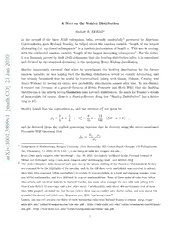
A Note on the Stanley Distribution PDF
Preview A Note on the Stanley Distribution
A Note on the Stanley Distribution Shalosh B. EKHAD1 In the second of the three AMS colloquium talks, recently masterfully2 presented by Algebraic Combinatorics guru Richard Stanley, he talked about the random variable “length of the largest alternating (i.e. up-down)subsequence” in a random permutation of length n. This was in analogy with the celebrated random variable “length of the largest increasing subsequence”. For the latter, 0 itwasfamouslyprovedbyBaik-Deift-Johansson thatthelimiting distribution(after itiscentralized 1 0 and divided by the standard deviation) is the intriguing Tracy-Widom distribution. 2 n Stanley humorously narrated that when he investigated the limiting distribution for the former a J random variable, he was hoping that the limiting distribution would be equally interesting, and 1 has already fantasized that he would be immortalized (along with Gauss, Poisson, Cauchy, and 2 Tracy-Widom) by having an exotic new probability distribution named after him. To his dismay, ] it turned out (because of a general theorem of Robin Pemantle and Herb Wilf) that the limiting O distributionis theutterly boring Gaussian (aka normal) distribution. Somuch for Stanley’s dream C of immortality (of course, there is a Stanley-Reisner Ring, but “Stanley Distribution” has a better . h ring to it!). t a m Stanley found that the expectation µn and the variance σn2 are given by [ 1 2 1 8 13 v µn = n + ; σn2 = n (for n 4) , 3 6 45 − 180 ≥ 9 9 8 and he deduced (from the explicit generating function that he derived, using the above-mentioned 3 Pemantle-Wilf theorem) that . 1 Xn µn 0 n := − Z σn 0 1 : 1 Department of Mathematics, Rutgers University (New Brunswick), Hill Center-Busch Campus, 110Frelinghuysen v i Rd., Piscataway,NJ 08854-8019,USA. c/o zeilbergat math dotrutgersdotedu , X http://www.math.rutgers.edu/~zeilberg/. Jan. 20, 2010. Exclusively published in the Personal Journalof r a Ekhad and Zeilberger, http://www.math.rutgers.edu/~zeilberg/pj.html, and arxiv.org . 2 The three colloquium talks delivered each yearduring the annualmeeting of the American Mathematical Society are supposed to be the highlights of the meeting, and, in the old days, every participant wasexpected to attend, since they were supposed (often successfully) to explain to non-specialists, in a lucid and engaging manner, some non-trivial mathematics, and were delivered by a great mathematician. Some of these series of talks were better than others, and the three lectures by Richard Stanley, last week, were amongstthe very best ones (along with Gian-Carlo Rota’s 12 years ago,and a few other ones). Unfortunately, only about400 participants (out of more than 5000 people!) attended the first lecture (where there was no conflict with shorter talks), and only about 150 attended the second and third ones. Shame on you,2010 “mathematicians”! Luckily, onecan still retrieve the slides of these fascinating talks fromRichard Stanley’s website: http://www- math.mit.edu/~rstan/transparencies/ids-ams.pdf, http://www-math.mit.edu/~rstan/transparencies/altperm- ams.pdf, http://www-math.mit.edu/~rstan/transparencies/redec-ams.pdf . 1 converge to the normal distribution, i.e.: n (in distribution). Z → N Thisisequivalenttothestatementthatthemomentsof n convergetothemomentsoftheGaussian distribution (0 for odd moments and 1 3 ... (2r 1) =Z (2r)! for the even, 2r-th, moment), to wit: · · · − 2rr! (2r)! α2r(Zn) = 2rr! +o(1) , α2r+1( n) = o(1) . Z So the leading terms for the asymptotics for themoments are indeed the boring, normalones. But, thanks to the amazing Maple package HISTABRUT, written by my master, Doron Zeilberger, that will soon be released with an accompanying article explaining how to use it, one can get: (2r)! 1 r(r 1)(10r 713) 1 α2r(Zn) = 2rr! 1+ 1764 − n − +O(n2) , (cid:18) (cid:19) α2r+1( n) = Z √10 (2r)! 1 1 (r 1) 1760r3 381744r2 +1430752r +150351 1 r 1+ − − + O( ) . − 43 2rr! √n − 931392 n n2 (cid:0) (cid:1) ! These formulas tell you how fast the moments of the (discrete) Stanley Distribution ( n) converge Z to those of the normal distribution. Zeilberger’s Maple package HISTABRUT can yield even higher-order asymptotics, but who cares?. Also,Ihavetoadmitthattheaboveformulasarenotyetrigorous,buttheyarecertainlyrigorizable. So there exists a rigorous proof, but who cares? 2
